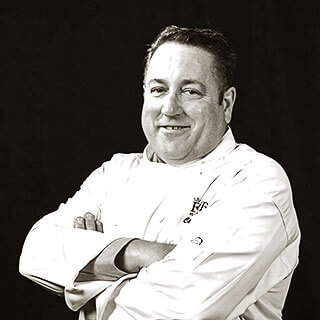Listen to This Article:
Mother sauces, first classified by French Chef Marie-Antoine Carême and later codified by Auguste Escoffier, form the foundation of French cuisine. These five essential sauces serve as the base for countless variations, transforming into ‘daughter’ sauces with the addition of different ingredients to complement and elevate a wide range of dishes.
Understanding and perfecting these sauces isn’t just about tradition—it’s about learning essential techniques such as thickening, emulsification, and balancing flavors—key culinary skills every chef needs, most especially sauciers. Whether you’re making a creamy Béchamel for a comforting mac and cheese or a rich Espagnole to accompany a perfectly-seared steak, these sauces provide the building blocks of countless recipes.
To celebrate our school’s namesake, Chef Instructors from Auguste Escoffier School of Culinary Arts have come together to create fun and useful videos demonstrating these five traditional sauces and offering fresh takes on how to further enhance them.
- Béchamel Sauce
- Velouté Sauce
- Espagnole Sauce
- Hollandaise Sauce
- Sauce Tomate
First up is Escoffier Manager of Content Development Luke Shaffer describing the process for creating the very versatile white roux-based sauce, Béchamel. If you want to try your hand at a sauce, get your mise-en-place ready and follow along with the chefs.
Béchamel Sauce
Béchamel is a rich, creamy, milk-based white sauce. If you’ve ever savored the golden, bubbling crust of a gratin or bitten into the crispy, buttery layers of a croque madame, then you’ve experienced the rich, velvety indulgence of Béchamel.
This sauce starts with a roux, a mixture of equal parts butter and flour cooked briefly to eliminate the raw flour taste and prepare it to absorb liquid. Since four of the five mother sauces begin with a roux, you’ll want to perfect this technique as it’s essential for sauce-making.
Yields 1 quart
Ingredients
- 2 oz unsalted butter
- 2 oz all-purpose flour
- 1 qt whole milk
Directions
- In a small sauce pot, gently warm milk – be careful not to boil or scorch.
- In a medium sauce pot, melt butter over medium heat.
- Whisk flour into butter to create a roux – be careful not to brown.
- While whisking, slowly add warm milk to the roux. Ensure no lumps remain.
- Reduce heat to low and allow sauce to cook just until raw flour flavor is cooked out. Stir occasionally to prevent scorching.
- Once complete, the sauce can be seasoned and flavored in any number of ways, depending on the final application.
Learn how to make Béchamel, the base of creamy mac and cheese, croque madame, and more.
One of the most popular daughter sauces of Béchamel is Mornay, made by stirring in grated cheese—typically Gruyère, Parmesan, or Cheddar. This rich, velvety sauce is the foundation of classic mac and cheese. You can also use it to make savory crepes. Another variation, Soubise sauce, is made by adding slow-cooked, pureed onions, creating a flavorful accompaniment for meats and vegetables.
Velouté Sauce
Velouté is a light, stock-based sauce that begins with the same foundational technique as Béchamel. A white roux is cooked just long enough to remove the raw flour taste, then blended with white stock—such as chicken, veal, or fish—to create a silky, delicately flavored sauce. While rarely served on its own, Velouté’s versatility makes it the ideal base for more complex daughter sauces, which are often paired with poultry and seafood in French cuisine.
Yields 5.75 oz
Ingredients
- 2 oz clarified butter or whole butter
- 2 oz flour
- 1 oz celery, small dice
- 1 oz parsnip, small dice
- 1 oz yellow onion, small dice
- 1 qt white stock
Sachet Ingredients
- ½ bay leaf
- ¼ tsp thyme
- ¼ tsp peppercorns
- 2 ea parsley stems
- to taste kosher salt
- To taste white pepper (optional)
Directions
- Heat clarified butter in a heavy saucepot over low heat.
- Add flour to make a roux.
- Add mirepoix (celery, parsnip, yellow onion) along with sachet ingredients.
- Gradually add the stock to the roux, whisking constantly. Bring to a boil, stirring constantly.
- Reduce heat to a simmer.
- Simmer the sauce very slowly for 1 hour. Stir occasionally and skim surface when necessary. Add more stock if needed to adjust consistency.
- If the Velouté is to be used as-is, season to taste with salt and white pepper. If it is to be used as an ingredient in other preparations, do not season velouté.
- Strain through a fine mesh strainer.
- Evaluate the finished sauce. Taste, season, and adjust as needed.
- Cover or spread melted butter on surface to prevent skin formation. Keep hot in a bainmarie, or cool in an ice bath for later use.
Once your Velouté is ready, you can transform it into Sauce Suprême by adding cream, creating a rich, velvety sauce often served with chicken. A Sauce Vin Blanc, perfect for pairing with fish and seafood, is made by infusing Velouté with white wine, enhancing its delicate flavor.
Escoffier Manager of Content Development Luke Shaffer demonstrates how you can make Velouté, a versatile base for many daughter sauces.
Breaking Down the Five Mother Sauces
Here’s a quick at-a-glance chart detailing the key components and thickening agents of mother sauces.
| Mother Sauce | Thickening Agent | Liquid/Base | Key Ingredients |
|---|---|---|---|
| Béchamel | White roux | Milk | Butter, flour, milk |
| Velouté | Blond roux | White stock (chicken, veal, or fish) | Butter, flour, white stock |
| Espagnole | Brown roux | Brown stock (beef/veal) | Mirepoix, tomato paste, stock |
| Hollandaise | Emulsification | Butter | Egg yolks, lemon juice, butter |
| Tomate | Blond roux | Tomatoes | Tomatoes, mirepoix, white stock, herbs |
Espagnole Sauce
Up next is Espagnole, or brown sauce, which is a deeply flavorful and robust mother sauce. Unlike Béchamel and Velouté, which start with a light roux, Espagnole begins with a darker roux, cooked longer to develop a rich, nutty, toasted flavor. It is then layered with mirepoix (diced onions, carrots, and celery), tomato paste, and finally, brown stock, creating its signature depth and complexity.
Toques off to Escoffier Online Chef Instructor Kevin Quinn, who demonstrates the third mother sauce, Espagnole.
Yields 2 quarts
Ingredients
- 8 oz brown roux
- 3 qt brown stock
- 1 qt additional brown stock
- 1 lb coarse chopped tomato
- 1 lb mirepoix
Directions
- In a deep thick sauce pan dissolve the roux adding 3 qt brown stock.
- Bring sauce to a boil while constantly stirring.
- Let the sauce simmer slightly off-center to create a convection of scum pooling to the side, Depouillage (skim) as needed.
- It is advisable to change saucepans 2 or 3 times during the cooking process straining with a chinoise/cheesecloth each time; approx cooking time 2 hours.
- Add additional brown stock to replace evaporated stock, 1 lb fresh tomatoes and Mirepoix.
- The sauce is then reduced to 2 qt desired quantity and strained an additional time.
One classic variation of Espagnole is Bordelaise sauce, which infuses Espagnole with red wine and shallots, creating a bold, savory complement to grilled steaks.
Another refined daughter sauce, demi-glace, is made by reducing Espagnole with additional brown stock until it reaches a highly concentrated, velvety consistency. This rich reduction is commonly used as finishing touch for braised short ribs, enhancing the meat with its glossy texture and intense depth.
*Information may not reflect every student’s experience. Results and outcomes may be based on several factors, such as geographical region or previous experience.
Espagnole Sauce Half-Glaze Variation
For a lighter alternative to the daughter sauce demi-glace, chefs often prepare half-glaze, or demi-espagnole. This variation is a partially reduced Espagnole, serving as a versatile base for many smaller brown sauces. It offers richness without the full concentration of demi-glace, making it an excellent foundation for further sauce development. Here’s how to make it:
Ingredients
- 1 qt finished Espagnole sauce
- 1 qt brown stock
- 4oz sherry
Directions
Reduce 1 qt of the Espagnole sauce and 1 qt brown stock until you achieve 1 qt: skimming constantly. Strain and finish with sherry. This is an excellent base for all smaller brown sauces.
Explore Espagnole, the rich brown sauce with many daughter variations.
Hollandaise Sauce
Hollandaise, perhaps the most famous of all sauces, is a luxuriously rich, butter-based sauce that demands both precision and patience. Unlike the other mother sauces, it doesn’t rely on a roux for thickening but instead comes together through emulsification, where butter is carefully incorporated into egg yolks to create a silky, velvety texture.
You may have indulged in this golden, buttery sauce drizzled over tender asparagus or cascading over perfectly poached eggs in Eggs Benedict, inspiring you to try making it yourself. But keep in mind—Hollandaise is as temperamental as it is delicious. It requires a gentle touch and steady heat to prevent the eggs from curdling, and the emulsion can break if not handled with care.
Let’s watch as Chef Instructor Clif Dickerson of the Escoffier Austin campus shares his secrets for the perfect Hollandaise Sauce – the 4th in our mother sauce series.
Ingredients
- 2 large egg yolks
- 1 Tbs fresh lemon juice
- 1/2 cup clarified butter
- Pinch of cayenne pepper
- Salt, to taste
Directions
- Start by clarifying the butter: In a small saucepan, melt unsalted butter over low heat. Skim off and discard the foam that rises to the top. Gently pour the clear, clarified butter into a separate container, leaving the milk solids behind. Set the clarified butter aside.
- Fill the bottom of a double boiler with a few inches of water and bring it to a gentle simmer over low to medium heat.
- In the top part of the double boiler, whisk together the egg yolks and lemon juice until well combined.
- Place the top part of the double boiler over the simmering water. Make sure the water doesn’t touch the bottom of the top pan.
- Slowly drizzle in the clarified butter into the egg yolk mixture while continuously whisking. Make sure to add the butter very gradually, so the sauce emulsifies properly.
- Continue to whisk gently as the sauce thickens. This should take about 10-15 minutes, and you want the sauce to reach a temperature of about 160°F (71°C).
- Season the Hollandaise sauce with a pinch of cayenne pepper and salt to taste. Adjust the seasoning to your preference.
- Once the sauce has thickened to your desired consistency (it should coat the back of a spoon), remove it from the heat.
- Serve the Hollandaise sauce immediately over poached eggs, vegetables, or your choice of dish. Enjoy!
Remember to maintain a gentle and steady heat, and to whisk continuously to prevent curdling and ensure a smooth sauce.
Egg yolks and butter come together in Hollandaise to create a delicious, creamy sauce.
Once perfected, Hollandaise opens up the door to exciting daughter sauces. You may already be familiar with the very popular daughter sauce, Béarnaise, which is deliciously indulgent served over steak frites or grilled salmon. This sauce is a tangy, herb-infused variation, made by adding a reduction of white wine vinegar, shallots, tarragon, and black peppercorns.
For a lighter twist, Mousseline Sauce (AKA Sauce Chantilly) offers a more delicate take on Hollandaise. By simply folding in whipped cream just before serving, this variation becomes airy and luxurious, making it an elegant accompaniment to poached sole or other delicate white fish.
Sauce Tomate
The final mother sauce is Sauce Tomate, a rich tomato-based sauce that can be used in a variety of applications. It starts with a fat such as olive oil, mirepoix, and a small amount of roux for thickening. The sauce is then built out with crushed tomatoes, light stock, and aromatics like bay leaf and thyme. It is slow-simmered for hours, allowing the flavors to meld and concentrate into a deep, hearty sauce.
The French version differs significantly from Italian-style tomato sauces. Sauce Tomate is thicker (thanks to the roux and reduction time) and has a deeply complex flavor from the slow cooking process.
Dr. Stephanie White closes out our mother sauce tribute with a demonstration of Sauce Tomate – the fifth and final in our mother sauce series. Dr. White is the Assistant Professor in Culinary Medicine at the University of Cincinnati and helped develop Escoffier’s Plant-Based programs; she served as Director of Academics at Escoffier.
Ingredients
- 2 oz olive oil
- 1.5 oz carrots, peeled and small-diced
- 1.5 oz white or yellow onion, small-diced
- 1 bay leaf
- 1 sprig thyme
- 1 oz all-purpose flour
- 1, 28-oz tomatoes, canned, crushed
- 1 cup vegetable stock
- Salt and pepper to taste
Directions
- Heat oil in a saucepan over medium heat.
- Add the carrots and onions, and allow to sweat until the onions are soft and translucent.
- Add in the flour to make a roux, and cook for about a minute or two until it is blonde in color.
- Stir in the bay leaf and thyme.
- Add in the crushed tomatoes and vegetable stock. Bring to a boil and reduce heat to low. Simmer for 90 minutes, stirring often to ensure the sauce does not burn.
- Once it has reduced and the flavor has had time to concentrate, remove the sauce from the heat. Remove the bay leaf and thyme stem, and pass through a food mill.
- Serve warm as desired or rapidly chill to store sauce until ready to use.
Sauce Tomate: a classic, rich tomato sauce you likely enjoy weekly in some variation.
Sauce Provençale, a vibrant daughter sauce of Sauce Tomate, hails from the Provence region of France. Infused with garlic, olives, white wine, and fresh herbs like thyme, basil, and oregano, it offers a light, aromatic flavor. This sauce is excellent served with grilled or pan-seared fish, or you may have tasted it in the famous ratatouille dish.
*Information may not reflect every student’s experience. Results and outcomes may be based on several factors, such as geographical region or previous experience.
From Mother Sauces to Endless Possibilities
Practicing and perfecting the five mother sauces not only enhances your cooking skills but also connects you to the rich traditions of classical French cuisine. By learning these foundational techniques, you’re following in the footsteps of legendary chefs and gaining the tools to create an endless variety of flavorful, restaurant-quality dishes.
If you’re ready to take your culinary expertise further, culinary school might be the perfect next step. At Auguste Escoffier School of Culinary Arts, you can gain hands-on experience, refine your technique, and unlock a world of creativity and experimentation through the art of sauce-making.
Have questions about our programs? Contact us today to learn more and take the first step toward the future you deserve.
LIKE THIS ARTICLE? YOU MIGHT ALSO ENJOY:
- Who Was Auguste Escoffier? The Story Behind the King of Chefs
- Why Study at a French Culinary Institute?
- How Chef Auguste Escoffier’s Legacy of Innovation and Training Chefs Worldwide Lives On
*This article was originally published on October 4, 2023, and has been updated.



